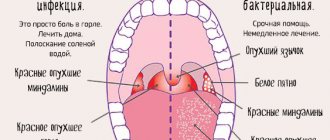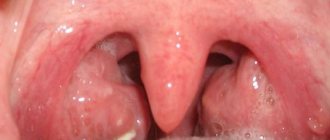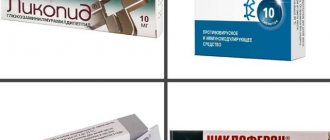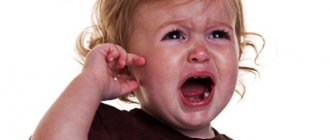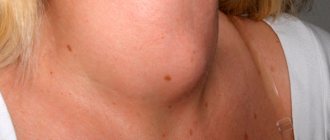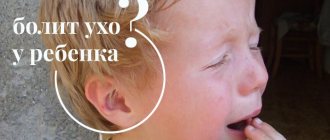Symptoms and signs
Despite the fact that an infant cannot directly indicate the source of discomfort, he will try in every possible way to make it clear that he is feeling unwell. In response to a sore throat, the baby's behavior will change. He will sleep worse, and his usual daily routine will be disrupted, if it was established by his mother. Sleep usually becomes episodic. Even if the baby falls asleep, after 30-40 minutes he wakes up again and begins to be capricious.
If inflammation in the throat interferes with normal swallowing, the child may refuse to eat altogether. At the same time, he will experience a feeling of hunger.
He will take the offered breast or bottle with formula willingly and greedily, but after a few seconds he will throw it away and begin to scream and cry shrilly. Feeding a baby with a sore throat is an incredibly difficult task.
The child will be capricious, cry and be indignant even outside of meals, because from time to time he needs to swallow saliva. If this process is quite painful, then it will certainly be accompanied by crying.
A symptom such as increased salivation is difficult to consider diagnostically important. Many children begin to drool long before 4 months, when the first tooth is expected to appear, and this is a variant of the physiological norm. Even if drooling began at 3 months, and the first tooth appeared at 7-8 months.
It should be noted that with inflammation in the throat area, the baby actually produces a slightly increased volume of saliva.
The fact is that saliva is the main antiseptic provided by nature for inflammation in the oropharynx. Therefore, the body, in response to the penetration of pathogenic microorganisms, reacts with increased production of saliva.
Sometimes a sore throat is preceded by a runny nose. In an infant, nasal congestion is not always painful due to the narrowness of the nasal passages. But while nasal breathing is disrupted, the baby breathes through the mouth, the mucous membranes of the larynx and tonsils dry out, and inflammation begins.
It should be noted that in addition to weak immunity in infants, there is another factor that contributes to the occurrence of ENT diseases. They have very loose mucous membranes. When viruses and bacteria get on them, they multiply faster, and the disease progresses rapidly.
How is the treatment carried out?
Drug therapy
Treatment of a sore throat is directly related to what factor provoked the problem. You can help an infant who is not yet six months old using antiseptics. They are applied to a sterile bandage that was previously wrapped around the finger, and the larynx is gently lubricated. Various sprays designed for gargling will also come to the rescue. They are mainly used for the treatment of small patients from 8 months. Medications called Orasept, Hexoral and Cameton are often used.
If the baby is more than 10 months old, treatment of the throat can be carried out using lozenges. “Doctor Mom” and “Lizak” are widely used. Inhalers are also prescribed, which help introduce saline solution, soda solution and various herbal infusions into the respiratory tract. The use of a nebulizer, which is a device for moistening the mucous membranes of the nasopharynx and administering medications with it, may also be prescribed.
It is also necessary to treat a baby's throat by rinsing the nasal passages. Typically, a medicine called “Aquamaris” is used for these purposes. If pain in the throat is accompanied by a runny nose, the small patient is prescribed drops that have a vasoconstrictor effect. "Rinazolin" and "Vibrocil" will come to the rescue. However, it is important not to forget that these pharmaceuticals can be used for no longer than 5 days.
How to care for a baby?
It’s good if parents give their baby raisin decoction.
In addition to the use of medications, doctors give parents general recommendations on how to improve the baby’s condition. First of all, you should not force your baby to eat. There is no need to worry that your child may lose a little weight during illness. When the baby recovers, he will gain weight. Food during therapy should be liquid and at room temperature. The little patient needs to be given fluids constantly. Sweetened weak tea, a decoction made from raisins, and natural fruit jelly are good for these purposes. In addition, doctors recommend putting the newborn to the breast more often, which will calm the baby and reduce the severity of pain.
In the room where the small patient is located, it is necessary to control temperature and humidity. It is important to ventilate the room at least 4 times a day. The temperature should not rise above 20 degrees Celsius. Doctors advise using humidifiers or placing containers of water in the room. An aroma lamp will also come to the rescue, where you can add your favorite essential oils.
Aromatherapy makes it possible to calm a small patient and moisturize the mucous membrane of the nasopharynx.
ethnoscience
To cure a sore throat, you can resort to gargling with a soda solution. To prepare this product, you will need to take 5 grams of the product and thoroughly dissolve it in 250 ml of water at room temperature. Instead of soda, you can take herbal decoctions; calendula and chamomile are perfect. To carry out the manipulation, you will need to place the baby on your knees, head down, and carefully inject the prepared product into your mouth using a syringe. It is important to ensure that the child does not swallow the resulting decoction and choking.
Diagnostics
If the changes described above have occurred in the baby’s behavior, the mother needs to conduct a preliminary examination of the baby to confirm or rule out a sore throat as a cause of concern. The only informative way is to examine the throat.
It must be carried out carefully, with clean hands, using a medical spatula or a teaspoon. There is no need to press hard on the root of the tongue - the baby will reflexively vomit. It is best to lightly press the center or tip of the tongue and slightly tilt the baby’s head back. For a better view, use a flashlight.
During the examination they evaluate:
- general view of the mouth and throat;
color of mucous membranes;
presence or absence of swelling and redness;
size and color of tonsils;
color of the posterior wall of the larynx.
The mouth and throat of a healthy child are pale pink. There may be a slight white coating on the tongue - this is normal for a baby who is predominantly on a milk diet. There is no normal swelling. Exceptions include gums if teething is expected soon. The tonsils are not enlarged, their color is even, pink. There are no noticeable blood vessels or redness on the back wall of the throat.
If the cause of the toddler's anxiety is a sore throat, then the mother will be able to see enlarged tonsils, a large amount of plaque that covers not only the tongue, but also the inside of the cheeks, the palate, and the back wall of the larynx.
Enlarged tonsils
Redness can be observed in the area of the tonsils, both palatine and pharyngeal, at the back of the throat. The change in color may be accompanied by the appearance of ulcers, blisters, pustules, caseous plugs (popularly referred to as casios).
It is imperative to palpate the submandibular and occipital lymph nodes; they may be enlarged. The temperature can range from low-grade (37.0-35.7) to high (with sore throat - up to 40.0 degrees), in some cases the temperature may even be normal.
If the mother does not find such alarming visual signs, she and the child should visit the pediatrician and together begin to look for another cause of restless behavior, appetite and sleep disturbances. If the throat is really sore, a doctor should be called to your home to prevent the spread of infection if the baby has a contagious illness.
You should not hesitate to contact us - untimely treatment for ENT diseases can lead to chronic forms of disease, complications, and impaired pulmonary respiration, which can cause suffocation. If a child wheezes, you should immediately call an ambulance.
Bacterial infections
Redness and severe pain in the throat are a consequence of the active growth and development of infections and viruses. Among them, the most dangerous are tonsillitis, diphtheria and scarlet fever. ARI has the same symptoms, but the child’s temperature is not too high. Viral diseases should be treated only under medical supervision, otherwise the risk of complications increases.
Sore throat is diagnosed in case of severe inflammation of the tonsils. Bacteria begin to actively multiply on them. In this case, the child’s temperature rises greatly and general weakness is observed. The tonsils increase in size and become covered with a layer of pus. The child experiences discomfort when swallowing. Most often, there is no snot with a sore throat. Treatment uses antibiotics and topical agents to eliminate bacteria.
Diphtheria develops against the background of the proliferation of the bacillus of the same name. Today, vaccination is considered quite effective in preventing this disease. If affected, the patient experiences an increase in body temperature, severe pain and redness in the area. Fibrous films may also appear on the mucous membrane. Treatment consists of introducing a special serum into the body.
The appearance of snot and wheezing in infants is associated with acute respiratory infections. During the treatment process, you will additionally need to constantly humidify the air and give the baby a sufficient amount of liquid.
If a sore throat occurs, a bacterial infection is also suspected. Antibiotics are used to eliminate it. However, only a doctor can prescribe them based on the results of a full examination. If you have the first symptoms, you should immediately seek help from a doctor.
Due to infancy, an infant cannot complain about his health or talk about his sore throat. That is why it can be very difficult to guess that the baby is bothered by unpleasant symptoms. The article will discuss how to understand that a baby has a sore throat, what are the possible causes, how to check a baby’s throat and help the baby, what can be done to prevent the occurrence of painful symptoms?
Throat diseases in newborns are a fairly common phenomenon.
Possible reasons
A newborn child has innate maternal immunity until about six months of independent life. After 6 months, his own immune system begins to gradually “learn.” And this happens when it comes into contact with viruses and bacteria. Nature has not come up with another, safer and more painless way.
Thus, the risk of contracting viral or bacterial infections increases after six months
, but in the first half of the first year of life, anything can happen.
The most common cause of sore throat in infants is respiratory viruses.
. It is quite problematic to “pick them up” while walking, especially in cold weather, but it is very easy in crowded places - clinics, shops, public transport. Viruses that enter through the nose can pass further, “settling” on the mucous tissues of the larynx, on the lymphoid tissue of the tonsils.
Viral sore throat
Healthy throat
Children under one year old learn about the world not only with their eyes, ears and touch, but also by taste. Partly for this reason, and partly because of the itching during teething, babies put absolutely everything that comes into their hands into their mouths. Together with a toy or other object, the baby may well introduce bacteria into the oral cavity, which live almost everywhere. Streptococci and staphylococci, which cause severe forms of sore throat, are especially dangerous. Bacterial and fungal infections of the oropharynx can also occur as a result of contact with an adult who carries the bacteria or with food, such as water.
During teething, your baby may also develop a sore throat. This is due to the work of local immunity. Since there is painful gum in the oral cavity during this period, if an infection occurs, the situation worsens significantly.
Allergies are another fairly common cause of oropharyngeal diseases in infants. Most often, an inadequate reaction of the body develops to chemicals contained in detergents and washing powders, which the mother uses to clean and wash the toddler’s diapers and bedding. Dry air and heat in the apartment are another factor in the appearance of inflammatory processes in the respiratory organs.
Treatment
In all cases, a doctor must treat a child up to one year old. Self-medication is unacceptable, since the risks to the baby’s life are too great.
This is why it is important to consult a doctor immediately after discovering problems with your throat. He will be able to determine what kind of disease happened to the baby. Laboratory capabilities will help the specialist with this - a throat swab will be thoroughly examined in order to detect the specific causative agent of the disease.
Once the virus, bacteria, fungus or allergen is known, the child will be given appropriate treatment. Quite often, infants with serious infectious diseases, including sore throats, are recommended to undergo therapy in a hospital setting under round-the-clock medical supervision. If the reason is not so serious, and the pediatrician is sure that the mother will follow all the instructions, then the child can be left to be treated at home.
Sore throat as a consequence of ARVI
Children immediately after birth cannot tell adults about their throat problems. That is why parents must learn to understand the presence of the disease on their own. With a sore throat, the baby behaves irritably and constantly cries. Mommy can’t calm him down even by suckling at the breast.
Pharyngitis in a newborn is diagnosed if there is inflammation in the throat. To do this, it is enough for parents to conduct a detailed examination of the pharynx. If there is a disease in the area of the pharynx, the child experiences swelling and swelling. Red tonsils and the posterior wall are observed in case of inflammation.
When examining a baby's throat in detail, you need to pay attention to the presence of plaque, ulcers and ulcers. If such manifestations are not detected, then the disease is caused by the virus entering the body. In this case, general health is aggravated by a runny nose and snot. Additionally, other symptoms of ARVI may also appear. Among them, the most dangerous are considered to be high fever and cough. When sputum is discharged from the lungs of an infant, the general health condition sharply deteriorates.
With ARVI, the pain may not even be noticeable. However, the baby experiences discomfort due to problems with swallowing and severe drying of this area. Against this background, some babies begin to breathe through their mouth.
Viral throat infections
For such ailments, no special treatment is needed, although most pediatricians try to prescribe antiviral drugs “just in case” - “Viferon”
in suppositories and other preparations in syrup or drops.
These drugs do not have clinically proven effectiveness, and therefore they, together with homeopathic antiviral remedies, are drugs that, at best, do not harm. There is no need to expect benefits. After a few days, the immune system will cope with the virus on its own, and taking medications does not in any way affect the speed of recovery.” , pre-irrigated with Miramistin antiseptic.
Vinilin can only be used if the child is not allergic to medications. For the smallest children, pediatricians recommend mixing the drug with sea buckthorn oil in a ratio of 1:5.
Bacterial and fungal diseases
In case of bacterial inflammation of the throat and oral cavity, the baby and mother will most likely be hospitalized, because the treatment of most such sore throats, candidiasis and even pharyngitis caused by bacteria requires the mandatory use of antibiotics.
Babies under one year of age usually begin treatment with a drug of the penicillin group. Additionally, they may recommend treating the throat with “Vinilin” or an oil solution “Chlorophyllipt”,
which shows high effectiveness against staphylococcus, which, as is known, cannot be destroyed by every antibiotic.
Fungal diseases can be successfully treated at home, they will include treatment with antifungal agents such as Quinozol
and taking oral antifungal drugs. You can find out what medications will be prescribed after determining the type of fungus.
- During periods of massive growth of respiratory viral infections, you should not visit
with a child up to one year old, places where there are many people at the same time. Walking is useful, but only where there is a lot of fresh air and almost no potential virus carriers - in a park or square.
Wash baby's underwear and clothes with baby hypoallergenic powders
. After washing, rinse items additionally. This will reduce the risk of allergic inflammation of the oropharynx.
To protect your baby's throat
, you need to maintain sufficient air humidity. It should not exceed 70%, and should not be lower than 50%. Heaters in a child's room dry out the air greatly. There is no need to place them indoors.
You should get preventive vaccinations on time
. Usually by 10 months the baby has already been vaccinated against most serious infections.
To learn how to treat a sore throat, watch the following video.
For small children under 1 to 2 years of age, it is very difficult to understand that they have a headache or anything else. At this age, the child will not be able to tell his parents about the deterioration of his health; children can only be capricious, scream and cry, attracting attention to themselves.
Babies may ask to be held more often than usual, and infants may literally “hang” on their chest. This disturbing behavior should alert parents. Be sure to touch the child's forehead to make sure there is no need to measure the temperature with a thermometer. If parents suspect that something is hurting their child, it is better to go to the pediatrician, who will help find out the cause of the restless behavior.
In itself, from a year to 3 years, there is no danger, only if it is not accompanied by any other symptoms. High temperature, nausea, vomiting, diarrhea, pallor, increased heart rate - the presence of one of these symptoms in combination with a severe headache is a reason to urgently seek medical help. Only a doctor can correctly diagnose the disease in a baby and decide what to do to get rid of all these symptoms. First of all, you need to contact a pediatrician, and he, in turn, can refer you to a more specialized specialist if there is such a need.
What measures can be taken?
If a child complains that he is tormented by headaches, this should not be ignored. Of course, a child can only complain when he or she is closer to 3 years old; before this age, he can only show by his appearance that something hurts him. You need to make sure that your body temperature is not elevated; you can do this by touching your forehead and measuring with a thermometer. When headaches are combined with a symptom such as high fever, you cannot do without medication. Tablets and medications must be appropriate for the baby’s age. only in the permitted dosage.
You can try to relieve pain without medication. You need to let the child lie down and rest in a cool room or even sleep. Compresses on the head help a lot, but you need to know how to do them. It is easier to make compresses for children under one year old, since the baby can be swaddled so that he does not throw off the compress. But you can also come to an agreement with older children - they already understand what exactly their parents are telling them. It is necessary to take cool water or room temperature into a bowl, moisten the gauze folded several times, and place it on the forehead. You can make such compresses for a long time, and there will be no damage to your health from them. Even if the temperature is elevated, they can help a lot. You can make compresses using essential oils of mint or lemon balm, but only after making sure that they will not cause allergies.
The child has a stomach ache
- This is one of the most common complaints when visiting a pediatrician. And in how many cases do they not go to the doctor when a child has abdominal pain? Every child may one day complain that his stomach hurts. Pain can be caused by a trivial cause that does not pose a great danger, or it can be a sign of a serious illness that requires immediate and drastic action. Therefore, it is very important to understand exactly where the stomach hurts and how it hurts.
The smallest children cannot say this in words, they cry. A baby's crying in the first months of life is often caused by pain in the tummy. Most often this is . However, a more serious reason is also possible: in children at an early age (most cases occur at the age of 5-9 months), with certain anomalies in the development of the intestine or the occurrence of intussusception (when part of the intestine enters the subsequent segment, like an umbrella into a cover), intestinal obstruction may occur requiring operative surgical treatment.
Red throat in a baby: what to do
A red throat in a newborn often causes panic in mothers, because not all drugs are allowed to treat a sore throat in a baby. This symptom accompanies a variety of diseases.
The most important thing is to determine the cause of the baby’s suffering and begin treatment in a timely manner. First of all, you need to call a pediatrician at home; self-medication is strictly contraindicated.
An experienced doctor will help determine what led to the redness of the throat and tell you how to treat your child’s throat according to his age.
Causes
Redness of the throat is a reaction of the child’s body to all kinds of irritants. Inflammation can be caused by viruses, bacteria, allergens or mechanical damage to the throat.
An experienced pediatrician can easily recognize the nature of the infectious process based on an examination of a small patient, based on possible accompanying symptoms, and advise on how to treat a baby’s throat. In complex cases, additional laboratory tests may be required.
Moms are strictly forbidden to rely on their own intuition and make a diagnosis on their own; such actions can lead to disastrous results.
Redness in the throat of infants often occurs during teething. Basically, this symptom goes away quickly and does not require special treatment.
But sometimes the process of teething is accompanied by fever, runny nose and cough, and some children endure it painfully. If there is constant pain during teething, it is important to prevent the infection from getting on the mucous membrane.
For this purpose, children are prescribed a number of preventive procedures, which your doctor will tell you about.
Acute respiratory disease can be recognized by the presence of accompanying symptoms, such as fever and intoxication, refusal to breastfeed, restless sleep, nervous and weakened condition of the child.
Urgent medical attention is needed if:
- acute pain in the throat bothers the child for more than 7 days, but there are no symptoms of a viral disease;
- the baby develops other symptoms in the form of severe coughing attacks, plaque and ulcers on the mucous membrane of the tonsils;
- the baby cries a lot, refuses to drink and breastfeed;
- the newborn wheezes when inhaling;
- severe manifestations of intoxication: pain throughout the body, the child’s refusal to move.
Sore throat is a very common cause of red throat in children under one year of age. It often occurs with minimal associated symptoms. Babies are only bothered by a red throat and a sore throat, while a complex bacterial infectious process develops in the throat.
Only a doctor can recognize this insidious condition, so do not hesitate to contact your pediatrician at the slightest concern of the child. With the right timely actions, you will save your baby from suffering and prevent the development of complex diseases.
First aid
The first and most correct action of a mother when a red throat is detected in a child is to call a pediatrician at home, even if there is no serious reason for concern. Accurate diagnosis by doctors will dispel your doubts about more complex diseases.
If an infant gets sick with ARVI, drug treatment is not prescribed, but recommendations for care are prescribed:
- Drink plenty of warm drinks. This will soften the neck, help quickly relieve symptoms of intoxication and quickly remove the infection from the child’s body.
- Moderate temperature and sufficient level of air humidity. In dry air, viruses quickly progress, and dry air irritates the child’s already inflamed mucous membranes.
- When teething, swollen gums are recommended to be lubricated with cooling ointments and analgesic gels for children.
- Frequent breastfeeding. Mother's milk is the best way to cure one-year-old babies, because the vitamins that milk is rich in are given by nature itself. In addition, it is an excellent psychological aid.
- If your baby's throat is red and rashes appear on his body, this is a manifestation of an allergic reaction. Do not use household chemicals; wash clothes only with baby hypoallergenic powder or baby soap. For acute allergies, children are prescribed antihistamines.
Medicines for children up to 6 months
After an examination and an accurate diagnosis, your attending physician will give individual recommendations on how to treat the throat of a child under one year old. Medicines have strict age restrictions and will be effective if the root cause of the disease is correctly identified.
For newborns and children under 3 months of age, herbal preparations are recommended for the treatment of acute respiratory infections.
- Homeopathic medicines can be safely given to children from the first month of life (Engistol, Gripp-Heel, Nervoheel, etc.) They have no adverse reactions and are effective against inflammatory processes at an early stage. The tablet is a convenient dosage form; it is easy to grind into powder and give to the baby.
- Rectal suppositories "Cefekon D" are indicated for the treatment of babies from 3 months. They have antipyretic and analgesic effects for acute respiratory viral infections and painful teething.
- An effective antipyretic agent is Panadol Baby syrup, it is recommended for children from 3 months of age.
- Since viruses often settle on the nasal mucosa, it is useful to irrigate it with sea water. Aerosol "Humer for children" can be used from birth by instilling 3 drops into each nasal passage or making one injection several times a day. The sterile water of the Adriatic Sea contains the drug “Aqua Maris”. It can also be used from birth by instilling a few drops 3 times a day.
Medicines for children after 6 months
Steam and ether inhalations are effective for treating red throat in children. They can be done covered with a large blanket. Add essential oils to water, three drops per 3 liters of water. Hot steam will warm your sore throat, and essential oils will have an antibacterial effect. Steam inhalations are effective at night, since the warm throat will remain warm for some time.
At 7 months, it is allowed to use homeopathy, for example Tonzilgon, for the treatment and prevention of a throat. For children 9 months old with viral and bacterial infectious processes, Paracetamol, Nurofen, Grippferon, and Viferon rectal suppositories are suitable.
The drug "Tantum Verde" will help cure a sore throat in a 10-month-old child. Although this medicine has an age limit of up to 2 years, it can be treated in young children by giving the solution from a spoon to the child without using a nebulizer.
A 9-month-old baby can already tolerate more “adult” medications, such as Miramistin, Efferalgan. Remember, medications based on aspirin and analgin are contraindicated for infants. If the red throat of a 9-month-old child is caused by a severe cough, treatment with Ambrobene, Lazolvan, and Ambroxol syrups is allowed.
Children 9-10 months old can smear the pacifier with an oil solution of chlorophyllipt; it has a softening, antibacterial and anti-inflammatory effect on the baby's throat. If the child does not take the pacifier, wrap a bandage around his finger and soak it in the solution so that the one-year-old baby can taste it. Chlorophyllipt, mixing with saliva, will imperceptibly treat the throat.
Babies 9 months and older are recommended to drink herbal teas and decoctions. They can also be given to younger children, but in this case, the concentration of the herbal mixture should be lower, since the plants can cause allergies.
Using herbal medicine all summer, you will fill your baby’s body with natural forces and properly prepare for the winter period.
Heal yourself while playing
All children get sick - that's a fact. Don't be upset, cheer yourself and your baby up by turning treatment into a game! During the inhalation process, you can play the game “peek-a-boo”. This way you will keep your child occupied and sit for the allotted time.
Use finger toys to coax your baby to open her mouth for the medicine. The idea of puppet shows is especially popular with children. You can carry out all the necessary procedures painlessly and have fun.
It is easier to cure a sore throat in a baby than to treat advanced forms of infectious processes, which, together with complex chemicals, will cause a serious blow to children's health.
Health to your children!
Olga Kondratyuk
Sources: medscape.com, health.harvard.edu, medicalnewstoday.com.
Source: https://globalmedclub.ru/lekarstva-gorlo/sredstva-i-preparaty/krasnoe-u-grudnichka.html
How do you know if your child has a stomach ache?
If the child cannot yet say what hurts, parents have to guess for themselves what is bothering their baby. Small children react to any pain by crying, however, if their tummy hurts, then in most cases this can be determined.
When gas accumulates, the tummy becomes noticeably rounded and becomes hard to the touch. The child pulls his legs towards his stomach, shudders for no apparent reason, and refuses to eat. If such signs appear, do not take risks - show the child to the doctor.
Abdominal pain in older children (boys and girls)
In older children, abdominal pain may result from:
- overeating and bloating as a result of gas formation;
- stretching of the abdominal muscles as a result of physical activity, as well as attacks of coughing, vomiting, etc.;
- inflammation of the stomach and intestines (gastroenteritis). In this case, pain is often preceded by fever, nausea, vomiting, and after an attack of pain, diarrhea is common;
- (rotavirus infection, which also has intestinal manifestations);
- appendicitis. Appendicitis is indicated by pain in the navel or lower right side of the abdomen. The temperature may rise, nausea, and slight diarrhea may occur. In case of appendicitis, immediate hospitalization is necessary;
- acute (inflammation of the pancreas). In this case, the pain is usually severe and can radiate to the shoulders, shoulder blades, or encircle. The abdomen is swollen and tense. The child takes a position lying on his side. Immediate hospitalization is required;
- acute inflammation of the kidneys (acute nephritis). In acute nephritis, abdominal pain is accompanied by urinary disturbances (urination occurs more often and in smaller volumes). Urine becomes dark in color. There is swelling under the eyes.
- inflammation of the lower segments of the lungs. Usually in this case, attacks of dry cough are observed before pain appears.
It should be remembered that the child is not always able to show where exactly his stomach hurts, and usually points to the navel area. Under no circumstances should you take painkillers on your own. In case of pain, the child must be shown to specialists to make a diagnosis and decide on further treatment tactics.
Almost all infectious diseases of the respiratory tract cause irritation, soreness and redness of the throat in children. This phenomenon is associated with the activation of unfavorable bacterial microflora, which must be combated.
However, first of all it is necessary to diagnose the child, which for a number of reasons can be quite a difficult task. With younger children, as a rule, this is due to poor communication skills, while older children often simply hide the problem. It is worth understanding the danger of infectious diseases, so it is extremely important to know how to understand that a child has a sore throat.
The health of absolutely any person must always be good to ensure normal functioning. The appearance of any problems cannot be ignored, so it is extremely important to diagnose and treat them in a timely manner.
The most common ailment in children is a sore throat. Almost always, this phenomenon is accompanied by redness of the nasopharyngeal mucosa and the appearance.
For timely diagnosis of a sore throat, the baby’s mother must always be attentive to the state of his health. Specifically, this is expressed in systematic examinations of the nasopharyngeal mucosa for redness and monitoring the general condition.
Most often, a sore throat in a child is accompanied by symptoms such as:
- deterioration of sleep
- decreased appetite or complete refusal to eat
- crying when swallowing
- Frequent “painful antics”
Of course, diagnosing throat problems using the above signs is important for children who cannot speak. If your child already knows how to talk, most likely he will let you know about the problem.
More information about the causes of sore throat in a child can be found in the video:
The final diagnosis can be made after a thorough examination of the throat mucosa. In the case where there really is a problem, it will be:
- red
- with plaque (white or yellow)
- have small wounds
All this symbolizes the onset of an inflammatory process in the baby’s body and the need to begin treatment.
Danger signs – when do you need a doctor?
Infectious bacteria, attacking the mucous membrane of the throat, seriously weaken the child’s immunity. Based on this, we can state the need for timely and correct therapy.
It is important to understand that sore throat is caused by the following dangerous diseases:
- diphtheria
- various colds
Timely diagnosis of the disease is not all that is needed in such an unpleasant situation. It is equally important to carefully analyze the entire etiological picture, highlighting the signs of the disease. The latter can be emergency indicators of the need to contact a pediatrician.
So, if your child exhibits the following symptoms, go to the clinic as soon as possible:
- heat
- chills or fever
- nausea or vomiting
- strong
- hoarseness or loss of voice
- choking cough
- severe loss of appetite
- general malaise, increased drowsiness
The danger of the manifestation of the above symptoms lies in the further, more serious development of all symptoms.
Even the mildest cold can lead to very dangerous complications in the future, so you should not ignore all additional symptoms.
The best option in such a situation is to consult a doctor, since only a specialist will be able to correctly diagnose the disease and prescribe the correct course of treatment.
It is worth noting that by suppressing the first manifestation of the symptoms of a sore throat, it is quite possible to get rid of the disease at the earliest stages. Naturally, it is necessary to treat the child as early as possible, but there is no need to immediately “feed” him with antibiotics, because you can do it in much more humane ways.
Suppressing the first signs of a sore throat in a child is carried out by carrying out a whole range of measures:
- First of all, provide the child with bed rest, even if the illness occurs in a harmless form. For the first couple of days, it is better to undergo treatment in a calm environment.
- Organize favorable environmental conditions for the small patient's respiratory system. The room where he is staying should have normal humidity, a comfortable temperature, no dust, etc.
- Constantly rinsing the nasopharynx is a fundamental part of success in the fight against sore throat. The procedure must be carried out every time after eating, at least 6-8 times a day.
- Let your child take mild antibacterial drugs, sprays, drops or syrups.
- Provide proper nutrition, which contains a lot of vitamin food and does not accept the presence of any foods that irritate the nasopharyngeal mucosa.
- It would also be a good idea to resort to inhalations. Options for both steam events and .
It is important to understand that the above procedures do not always help, because sometimes it is simply impossible to avoid the further development of the disease. Therefore, for the most effective treatment, show your child to a specialist.
Drug treatment
Every adult, especially a parent, knows that the basis of treatment for any ailment is taking medications. The prescription of the latter can only be entrusted to a doctor, so when self-medicating, be very careful and attentive. The main thing in such a process is not to make things worse.
There are various ways to combat a sore throat, the main one being the use of the following medications:
- irrigation sprays and aerosols: , Ingalipt, .
- antibacterial tablets for oral administration: Zinnat,
- rinsing solutions.
However, it is important to understand that it is necessary to fight the cause of the symptoms, that is, the disease itself. The general course of treatment for a child should include:
- antibacterial drugs: Amoxicillin, Cefazolin.
- antitussive medications: , Ambrobene, .
- the above remedies to combat a sore throat.
- nasal drops: .
- antihistamines: Suprastin.
In each individual case, different medications may be necessary, which should be prescribed depending on the age of the child and his illness. The only correct course of treatment can only be prescribed by a pediatrician.
Treatment with antibiotics
In cases where the disease in a child is quite serious, a completely rational solution would be to prescribe antibiotics. It is worth understanding that organizing the administration of these medications is an extremely responsible undertaking.
Therefore, it is advisable not to self-medicate and consult with a pediatrician, because each individual case requires a special approach.
In most cases of a child contracting an ENT disease and developing a sore throat, 4 types of antibiotics are prescribed:
- Fluoroquinolones are the most potent drugs aimed at treating ailments in advanced situations: Avelox or Levofloxacin.
- Cephalosporins are also quite powerful drugs, aimed primarily at getting rid of long-term respiratory diseases: Aksetin or Zinnat.
- Macrolides are universal drugs that can effectively fight diseases in various forms: or.
- Penicillins are the most frequently prescribed and effective medications in the treatment of respiratory ailments in children: Amoxicillin or.
When arranging for a child to take antibacterial drugs, it is important to take into account all the recommendations for their use presented in the instructions. The average course of treatment lasts 7-14 days. It is important to combine antibiotics with medications that protect the intestinal microflora, otherwise there is a risk of causing irreparable harm to the child’s health.
Folk recipes
The main treatment for sore throat in a child and the disease that causes it, without a doubt, should be carried out with medications. However, it is quite possible to use various folk recipes as a help. It is worth understanding that some of them are not applicable to very young children, as well as for children who are allergic to the components of a particular product.
So, below are five main folk remedies that can help get rid of sore throats in children:
- Vitamin tea. This tool is familiar to absolutely everyone. Preparing it is quite simple: brew tea and flavor it with some source of vitamins, for example, honey, dried fruits or herbal decoction.
- Juice . This “drug” will help greatly if you lubricate the mucous membrane of the throat with it a couple of times a day. To prepare, simply mix water with plant juice in a 4:1 ratio. 10 grams of product is enough for one lubricant.
- Herbal inhalations. A striking example of such a folk remedy is 2-3 tablespoons of a mixture of yarrow, St. John's wort, eucalyptus and, poured with half a liter of boiling water. It is important to breathe the steam from the product for at least 10 minutes.
- Foot bath made from chamomile infusion. It’s easy to make such a medicine; all you need to do is steep a couple of tablespoons of dry herbs in a liter of water for 2 days. Then you need to add a third of the resulting infusion to a container with warm water and place the child’s feet there.
Inhalation with a nebulizer
Using a special device for steam inhalation will help to finally get rid of a child’s sore throat and combat ENT disease. This method is extremely effective and can be used completely safely from 1.5 years of age.
The following solutions for inhalation are most effective:
- alcohol tincture: ratio 1:20 with saline solution
- Tonzilong: ratio: 1:1 (+6 years) and 1:2 (from 1 year to 6 years) - with the same physical. solution
- in its pure form is excellent for the treatment of ENT diseases in children
Instructions
Monitor your child closely if he has a cold. If a child has recently suffered from a respiratory disease, then otitis media can develop as a complication quite easily. A single entry of mucus from the nasopharynx into the ear canal is sufficient.
Take the child's temperature. With otitis, it is most often elevated, and can reach 39 degrees Celsius and higher.
Press on the tragus of the baby's ear. With otitis media, he will scream and cry or become very worried. The tragus is the tubercle of the ear that opens the external auditory canal. This way you can determine if your baby’s ear is sick.
Call your doctor even if you suspect ear pain. Timely treatment will help avoid complications.
Video on the topic
note
Remember that if you have an ear disease, you cannot self-medicate; the child must be examined by a doctor. If the eardrum is damaged, and this can happen already on the first day of the disease, then even the most harmless drops in the ear can lead to a worsening of the condition.
You should be especially wary if there is purulent discharge from the auricle. If they are present, then it is strictly forbidden to put a compress on the ear and any warming procedures.
Helpful advice
Otitis is divided into diseases of the outer ear and middle ear. Most often they develop after a respiratory illness due to inflammation of the nasopharynx. If a child has a weakened immune system, then ear inflammation can become chronic, which is much more difficult to treat. In addition, in young children, inflammation can develop due to milk or formula entering the auditory tube, which is also common.
Sources:
- All about ear pain in children
- Otitis in a child
- child's ears hurt
If your baby becomes restless, cries and has difficulty falling asleep, it is possible that his ears are simply bothering him. It is often difficult for a mother to recognize what exactly is hurting her baby, since he cannot talk about his problems. Therefore, you should be attentive to the whims, because often the cause of ear pain in infants is various ear infections.
Drug treatment for sore throat
Proper treatment of the disease is the key to a speedy recovery
Remember, all manipulations and medications should be carried out only as prescribed by a doctor. Giving your baby any medications on your own is strictly prohibited.
To avoid the appearance and accumulation of mucus in the nose, be sure to rinse it with saline or saline. Remember, if a child has a runny nose, mucus flows down the inner wall of the throat, simultaneously irritating it and causing infection.
If, in addition to a runny nose and sore throat, there is also a high temperature that is difficult to bring down, then a sore throat can be suspected. In such cases, you cannot do without antibiotics. But they should be prescribed only by a pediatrician and taken in a strict dosage.
In addition, it will be useful to drink bifidobacteria so as not to harm the child’s stomach.
Most drugs can be used for children over 2 years of age, so you need to be very careful and carefully choose the drug that will be used to treat an infant.
A sore throat in an infant is an alarming symptom that causes a lot of trouble, both for the baby and his parents. Children at this time become especially capricious and whiny. You should not be angry with your child; you need to find a way to rid the child of the disease as quickly as possible by contacting a pediatrician.
The video contains useful tips:
04 Apr 2020 Yuki 357
Share this post
We recommend reading along with this article
- Your child has a very sore throat, how to quickly relieve the pain
- If a newborn has trouble falling asleep, how can you help your baby?
- When your baby's urine is bright yellow
- How to teach a child to eat independently: principles and recommendations
- What is the normal temperature for a person, how to measure it,...
- How to make a children's room with a unique and inimitable design
- Swamp-colored feces - what are the causes of the disorder?
- A 1-year-old child does not sleep well at night - reasons
- Why your child doesn’t eat well: let’s find out together
Discussion: 3 comments
- Catherine:
05/03/2017 at 00:20My baby apparently inherited throat problems from me; he also gets a sore throat as soon as he has a cold. That's how many times we've had sore throats, we're 1.3 now, they didn't prescribe us anything other than iodinol.
Answer
- Irina:
08/22/2017 at 12:01
We haven't encountered sore throat yet. But with ordinary sore throats (during ARVI), we saved ourselves by drinking plenty of warm drinks and using a humidifier. And when the baby was still breastfeeding, I gave him breastfeeding on demand. Usually, in this mode, our throat stopped hurting on the third day.
Answer
- Angelina:
01/27/2020 at 11:25
My daughter got sick for the first time at the age of 10 months; she herself could not figure out what was wrong with the child’s throat; she had a high temperature. The doctor diagnosed ARVI, the throat was treated with chamomile decoction.
Answer
Symptoms of ear infections
To accurately recognize that it is pain in the ears that causes a certain discomfort, you should gently press on. This is the name given to the part of the ear that covers the entrance to the canal. If you noticed that this procedure is unpleasant for the baby, he cried and shuddered, this means that there are still problems with the ears.
You should immediately seek help from a professional medical facility if you have the following symptoms:
He is capricious and began to behave worse; - sleeps poorly, especially at night, screams, moans in his sleep; - became restless and irritable; - greenish or from the ear, sometimes mixed with blood; - nasal discharge; - the temperature has risen.
